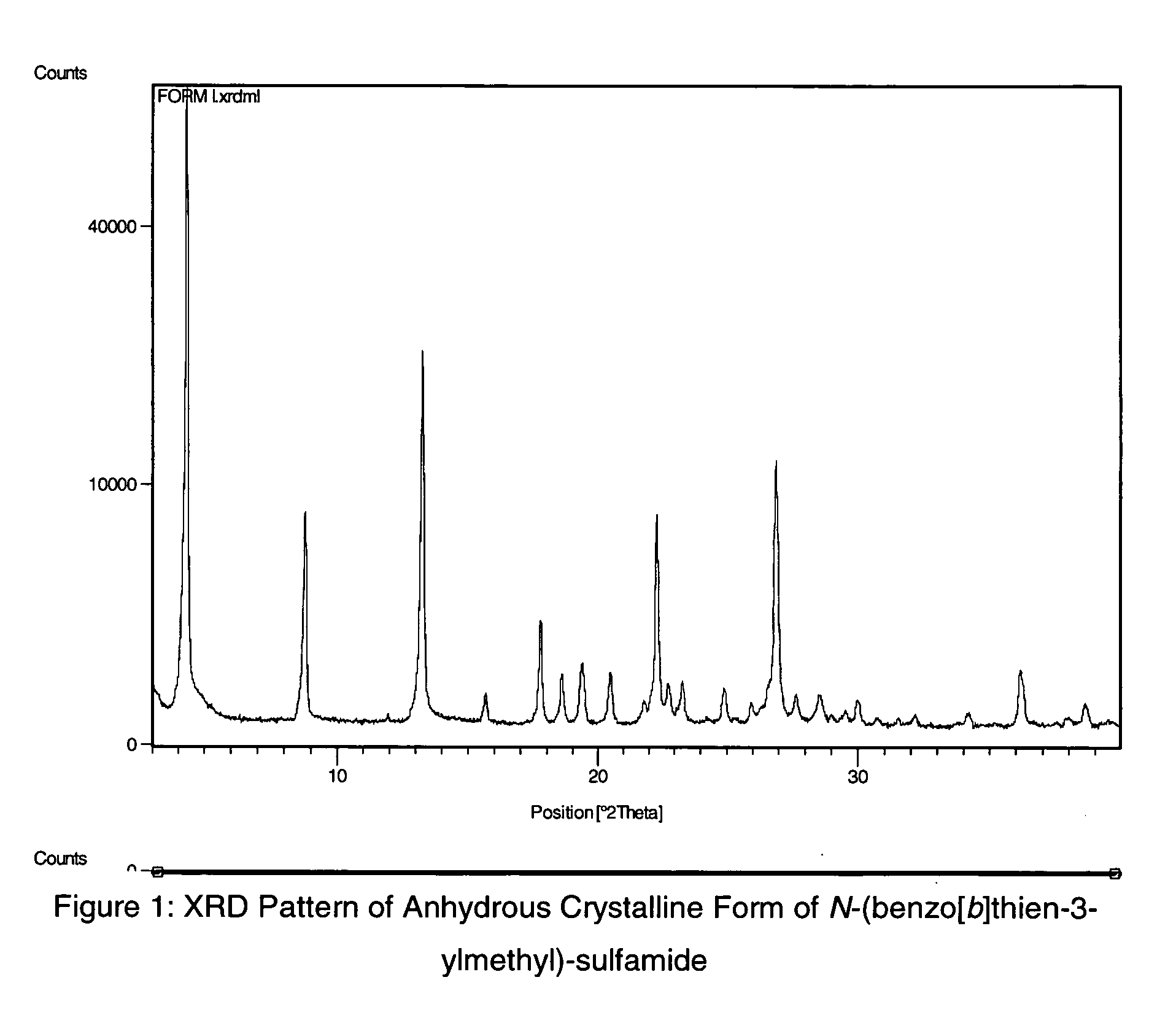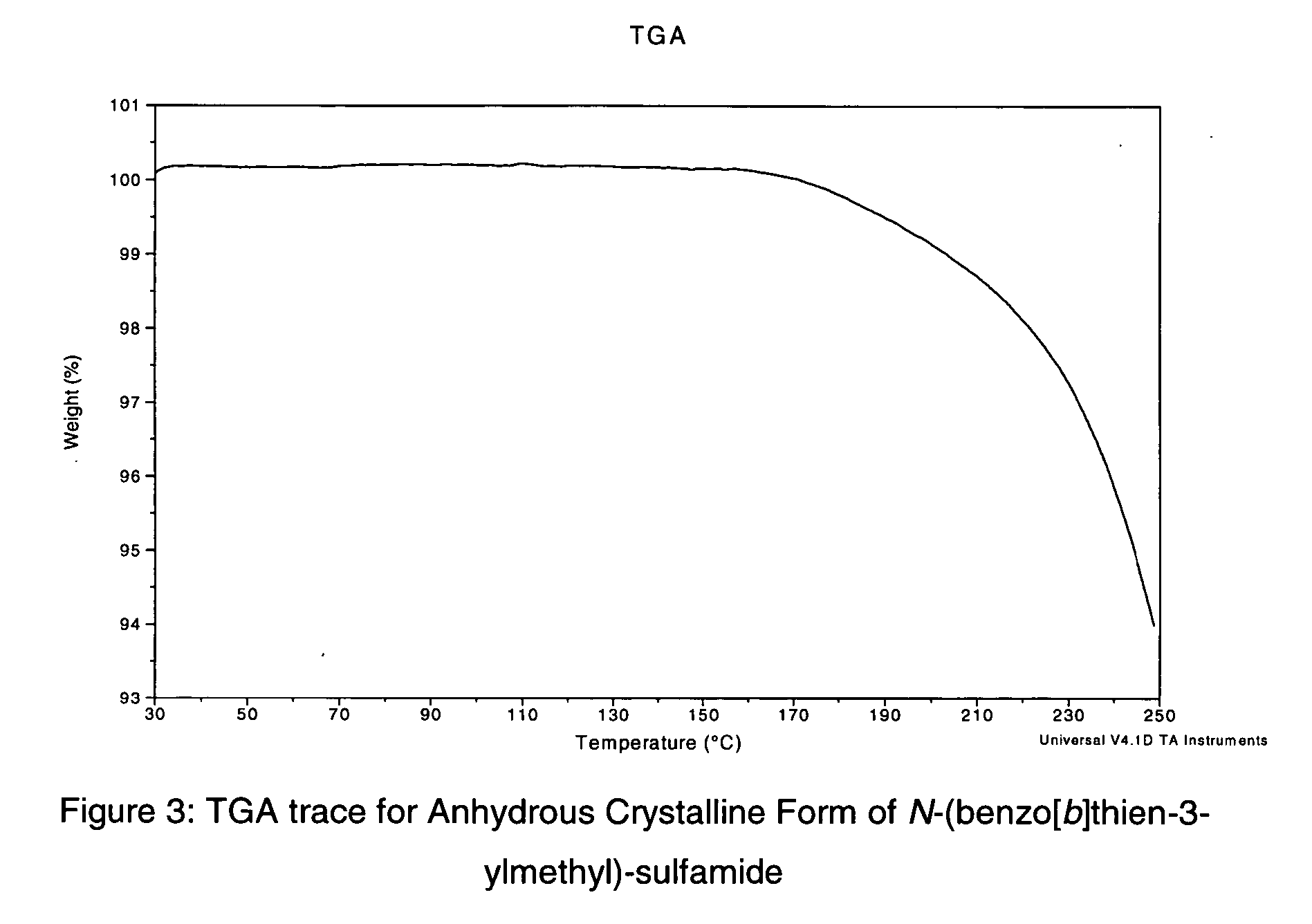Novel benzo-fused heteroaryl sulfamide derivatives useful as anticonvulsant agents
a technology of benzo-fused heteroaryl sulfamide and derivatives, which is applied in the field of new benzo-fused heteroaryl sulfamide derivatives, can solve the problems of systemic antiglaucoma agents such as acetazolamide, which have potentially unwanted side effects, and suffer from severe breathing and partial airway obstruction
- Summary
- Abstract
- Description
- Claims
- Application Information
AI Technical Summary
Benefits of technology
Problems solved by technology
Method used
Image
Examples
example 1
A(benzo[b]thien-3-ylmethyl)-sulfamide (Compound #1)
[0171]
[0172] Thianaphthene-3-carboxaldehyde (1.62 g, 10.0 mmol) was dissolved in anhydrous ethanol (50 mL). Sulfamide (4.0 g, 42 mmol) was added and the mixture was heated to reflux for 16 hours. The mixture was cooled to room temperature. Sodium borohydride (0.416 g, 11.0 mmol) was added and the mixture was stirred at room temperature for three hours. The reaction was diluted with water (50 mL) and extracted with chloroform (3×75 mL). The extracts were concentrated and chromatographed (5% methanol in DCM) to yield the title compound as a white solid.
[0173]1H NMR (DMSO-d6): δ7.98 (1H, dd, J=6.5, 2.3 Hz), 7.92 (1H, dd, J=6.6, 2.4 Hz), 7.62 (1H, s), 7.36-7.45 (2H, m), 7.08 (1H, t, J=6.3 Hz), 6.72 (2H, s), 4.31 (2H, d, J=6.3 Hz).
example 2
N-[(5-chlorobenzo[b]thien-3-yl)methyl]-sulfamide (Compound #3)
[0174]
[0175] (5-Chloro-1-benzothiophene-3-yl)methylamine (0.820 g, 4.15 mmol) and sulfamide (2.5 g, 26 mmol) were combined in anhydrous dioxane (50 mL) and the mixture was heated to reflux for four hours. The reaction was cooled and diluted with water (50 mL). The solution was extracted with chloroform (3×75 mL). The extracts were concentrated and chromatographed (5% methanol in DCM) to yield the title compound as a white solid.
[0176]1H NMR (DMSO-d6): δ8.05 (2H, m), 7.74 (1H, s), 7.40 (1H, d, J=6.5 Hz), 7.07 (1H, t, J=6.3 Hz), 6.72 (2H, s), 4.26 (2H, d, J=6.4 Hz).
example 3
N-[(1-methyl-1H-indol-3-yl)methyl]-sulfamide (Compound #7)
[0177]
[0178] N-Methylindole-3-carboxaldehyde (1.66 g, 10.4 mmol) was dissolved in anhydrous ethanol (50 mL). Sulfamide (4.5 g, 47 mmol) was added and the mixture was heated to reflux for 16 hours. Additional sulfamide (1.0 g, 10.4 mmol) was added and the mixture was heated to reflux for 24 hours. The mixture was cooled to room temperature. Sodium borohydride (0.722 g, 12.5 mmol) was added and the mixture was stirred at room temperature for one hour. The reaction was diluted with water (50 mL) and extracted with DCM (3×75 mL). The extracts were concentrated and about 1 mL of methanol was added to create a slurry which was filtered to yield the title compound as a white powder.
[0179]1H NMR (CD3OD): δ7.67 (1H, d, J=5.9 Hz), 7.32 (1H, d, J=6.2 Hz), 7.14-7.19 (2H, m), 7.06 (1H, dt, J=7.7, 0.7 Hz), 4.36 (2H, s), 3.75 (3H, s) MS (M−H)− 237.6.
PUM
| Property | Measurement | Unit |
|---|---|---|
| Temperature | aaaaa | aaaaa |
| Percent by mass | aaaaa | aaaaa |
| Fraction | aaaaa | aaaaa |
Abstract
Description
Claims
Application Information
 Login to View More
Login to View More - R&D
- Intellectual Property
- Life Sciences
- Materials
- Tech Scout
- Unparalleled Data Quality
- Higher Quality Content
- 60% Fewer Hallucinations
Browse by: Latest US Patents, China's latest patents, Technical Efficacy Thesaurus, Application Domain, Technology Topic, Popular Technical Reports.
© 2025 PatSnap. All rights reserved.Legal|Privacy policy|Modern Slavery Act Transparency Statement|Sitemap|About US| Contact US: help@patsnap.com



